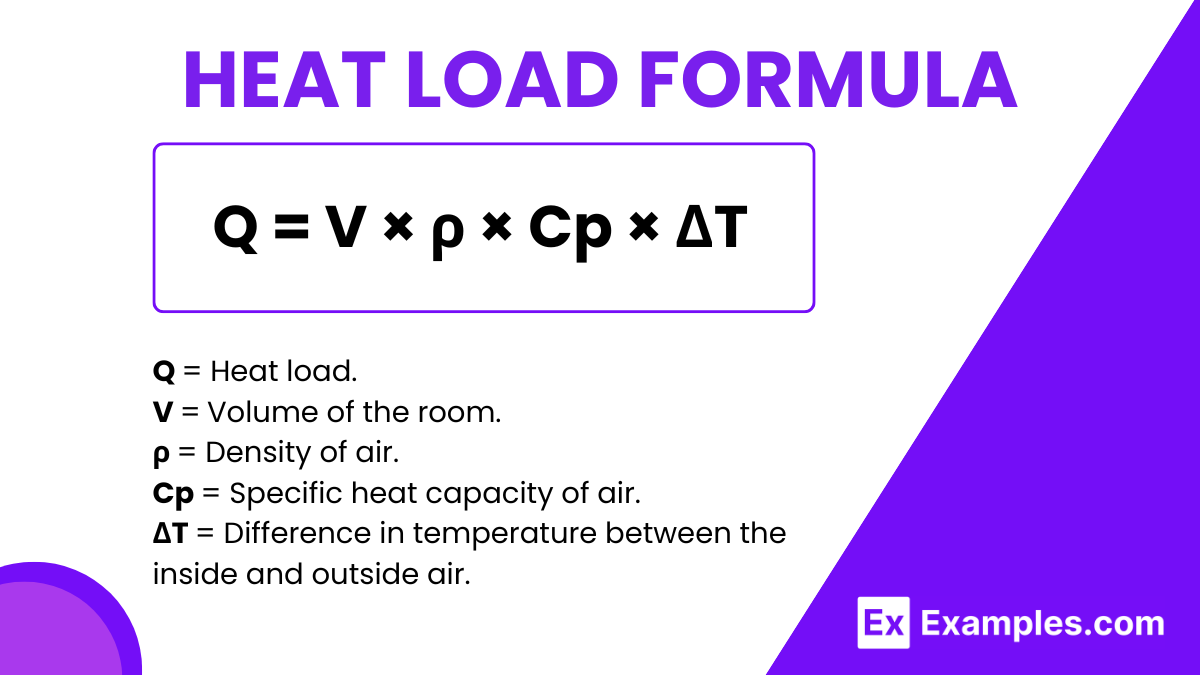What is the basic formula for calculating heat load in a space?
Q = mcΔT
Q = UAΔT
Q = mL
Q = PVnRT


The Heat Load Formula is crucial in the field of physics for calculating the total amount of heat energy that needs to be removed from a space to maintain a specific temperature. This formula helps in designing efficient heating, ventilating, and air conditioning (HVAC) systems, ensuring that environments remain comfortable regardless of external conditions. Essentially, it measures the heat energy that various sources—such as appliances, occupants, and lighting—add to a space, and it also accounts for heat transfer through walls, windows, and other surfaces.
The concept of heat load was significantly developed by Willis Carrier, the inventor of modern air conditioning, though the basic principles of thermodynamics involved were established by earlier physicists like Lord Kelvin and James Clerk Maxwell. The Heat Load Formula varies in its complexity; it can be as straightforward as multiplying the volume of the room by a constant that represents the heat gain per unit volume, or it can involve more detailed calculations that consider the specific characteristics of the room and its use. The formula typically looks something like this:
Problem: Calculate the heat load for a small classroom that is 10 meters long, 10 meters wide, and 3 meters high. The temperature difference between the inside and the outside is 5°C. Assume the density of air is 1.225 kg/m³, and the specific heat capacity of air is 1005 J/kg·K.
Solution:
Calculate the volume of the room: 𝑉 = length × width × height = 10 m × 10 m × 3m=300 m³
Apply the Heat Load Formula:
𝑄 = 𝑉 × 𝜌 × 𝐶𝑝 × Δ𝑇 = 300 m³ × 1.225 kg/m³ ×1005 J/kg\cdotpK × 5 K
Calculate the total heat load:
𝑄 = 300 × 1.225 × 1005 × 5 = 1,843,875 J
The heat load required to maintain the desired temperature in the classroom is 1,843,875 Joules.
Problem: Determine the heat load for an office space of 500 m³ volume, with 10 occupants, each generating 100 watts of heat, and 5 computers generating 300 watts each. The temperature difference is not considered in this calculation.
Solution:
Calculate the heat generation from occupants:
𝑄ₒ꜀꜀ᵤₚₐₙₜₛ = number of occupants × heat per occupant = 10 × 100 W=1000 W
Calculate the heat generation from computers:
𝑄꜀ₒₘₚᵤₜₑᵣₛ = number of computers × heat per computer=5 × 300 W=1500 W
Add the heat loads:
𝑄ₜₒₜₐₗ = 𝑄ₒ꜀꜀ᵤₚₐₙₜₛ + 𝑄꜀ₒₘₚᵤₜₑᵣₛ = 1000 W + 1500 W = 2500 W
The total heat load to be removed from the office is 2500 watts.
Problem: A laboratory room of 200 m³ volume, with a window area of 20 m², loses heat through the windows at a rate of 50 W/m². Calculate the heat load if the temperature difference is 8°C, with the same air properties as in Example 1.
Solution:
Calculate the heat loss through windows:
𝑄 = window area ×heat loss per unit area = 20 m² × 50 W/m²=1000 W
Calculate the heat load due to air volume and temperature difference:
𝑄ₐᵢᵣ = 𝑉 × 𝜌 × 𝐶𝑝 × Δ𝑇 = 200 m³ × 1.225 kg/m³ × 1005 J/kg\cdotpK × 8 K
Calculate the total heat load:
𝑄ₐᵢᵣ = 200 × 1.225 × 1005 × 8 =1,966,800 J
Add the heat losses:
𝑄ₜₒₜₐₗ = 𝑄ₐᵢᵣ +𝑄 = 1,966,800 J + 1000 W =1,967,800 J
The total heat load, including heat loss through the windows, for the laboratory is 1,967,800 Joules.
To calculate heat load from watts, sum all internal and external wattage sources affecting the space’s temperature.
The heating flow rate formula is 𝑄˙ = 𝑚˙ × 𝐶𝑝 × Δ𝑇, where 𝑚˙ is mass flow rate.
HVAC load calculation involves assessing total heat gains (internal + external) using the heat load formula adjusted for the specific environment.
Text prompt
Add Tone
10 Examples of Public speaking
20 Examples of Gas lighting
What is the basic formula for calculating heat load in a space?
Q = mcΔT
Q = UAΔT
Q = mL
Q = PVnRT
If U is the overall heat transfer coefficient, A is the area, and ΔT is the temperature difference, what does Q represent in the formula Q = UAΔT?
Heat capacity
Heat energy
Heat transfer rate
Heat load
How does increasing the overall heat transfer coefficient (U) affect the heat load (Q)?
It decreases Q
It increases Q
It has no effect on Q
It makes Q zero
In the formula Q = UAΔT, what does the term 'A' stand for?
Amplitude
Area
Area
Altitude
What is the effect of increasing the area (A) on the heat load (Q) in the formula Q = UAΔT?
It decreases Q
It increases Q
It has no effect on Q
It makes Q zero
In the heat load formula Q = UAΔT, what does ΔT represent?
Difference in time
Temperature difference
Thermal conductivity
Transfer coefficient
If the temperature difference (ΔT) is doubled, what happens to the heat load (Q)?
Q is halved
Q remains the same
Q doubles
Q becomes zero
Which factor does not affect the heat load in the formula Q = UAΔT?
Overall heat transfer coefficient
Area
Temperature difference
Specific heat capacity
What is the unit of the overall heat transfer coefficient (U) in the formula Q = UAΔT?
W/m²K
J/kgK
W/K
J/m²
If the area (A) is 50 m², U is 2 W/m²K, and ΔT is 10 K, what is the heat load (Q)?
1000 W
2000 W
500 W
2500 W
Before you leave, take our quick quiz to enhance your learning!

